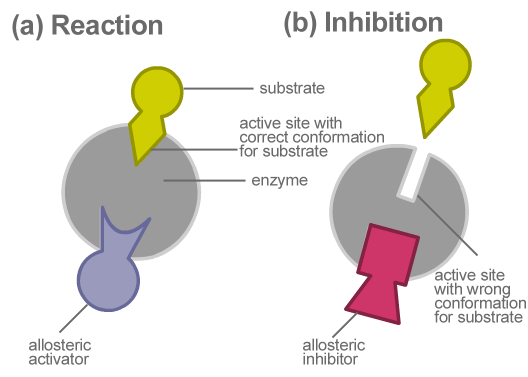Definition
Allosteric inhibition is the slowing down of enzyme-catalzyed chemical reactions that occur in cells. These metabolic processes are responsible for the proper functioning and maintenance of our bodies’ equilibrium, and allosteric inhibition can help regulate these processes.
Essentially, metabolic processes break down and build up important molecules. They are fundamental for anything from the digestion of the food we eat to the repairing of our muscles after we work out.

Lock and Key: Substrate Binds to Enzyme at the Active Site
Metabolic processes consist of a series of chemical reactions that produce end products. The key drivers of metabolic processes are enzymes. Enzymes are specific proteins that catalyze reactions. These enzymes speed up important chemical reactions in cells by reducing the amount of energy that is required.
First, an enzyme binds to a substrate. This reaction then creates a product. The product can then serve as a subsequent substrate for a different enzyme at the next metabolic step. Finally, there is a chain of reactions that occur until a final product is created at the end.
One important point is that the binding of an enzyme and its substrate is very specific. The enzyme can be compared to a lock and the substrate can be compared to a key. Certain substrates can only bind to certain enzymes. They bind at a location on the enzyme called the ‘active site’.

The wrong key will not fit the specific lock on an enzyme. If the substrate cannot fit into an active site, the enzyme cannot catalyze a reaction. Even if the substrate is the correct substrate for an enzyme, an allosteric inhibitor can prevent the enzyme from having the correct shape or conformation.
Allosteric Inhibition Inhibits Enzymatic Activity
To control the speed of metabolic reactions, we have what is called allosteric inhibition. Allosteric inhibitors slow down enzymatic activity by deactivating the enzyme. An allosteric inhibitor is a molecule that binds to the enzyme at an allosteric site. This site is not at the same location as the active site. Upon binding with the inhibitor, the enzyme changes its 3D shape.
Allosteric inhibition is a form of noncompetitive inhibition. This means that the inhibitor is not directly competing with the substrate at the active site. Instead, it is indirectly changing the composition of the enzyme.
After changing its shape, the enzyme becomes inactive. It can no longer bind with its corresponding substrate. This will then slow down the formation of subsequent products. Think of the allosteric inhibitor as a locksmith. The locksmith (i.e. allosteric inhibitor) changes the lock (i.e. enzyme) so that the key (i.e. substrate) will no longer be able to open the lock (i.e. enzyme).
Allosteric Inhibition Prevents the Over-Accumulation of Products
Allosteric inhibitors prevent the body from wasting energy to create unnecessary products. Think of a metabolic pathway as an assembly line at a factory. At each station in the assembly line, a machine alters the product before passing it to the next station. The assembly line then moves intermediate products from station to station until there is a final product at the end.

Say that this factory is responsible for producing pants. At the first station, a machine cuts a pair of pants from raw material. Subsequently, a machine at the second station stitches the hems of the pants together. At the third station, a machine attaches the zippers. After that, a machine at the fourth station attaches tags and places the product in the shipment pile. When the machines are working properly, the assembly line is smooth and there is no hold-up. Stations will produce products at similar rates.
However, imagine that one day, the machine that attaches the zippers at the third station breaks down. There is now a hold-up. To prevent products from piling up, we must stop the first few stations of the supply line from operating. This is to control the supply and demand for each intermediate product and to ensure that they are equal at each station.
Similarly, allosteric inhibition slows down the chain of reactions. In this way, it prevents the over-accumulation of unnecessary products.
Examples of Allosteric Inhibition
An example of an allosteric inhibitor is ATP in cellular respiration. This metabolic process operates as a feedback loop. In this loop, downstream products control the speed of upstream reactions.
One enzyme involved in glycolysis is phosphofructokinase. It converts ADP to ATP. When there is too much ATP in the system, the ATP serves as an allosteric inhibitor. It binds to phosphofructokinase to slow down the conversion of ADP. In this way, ATP is preventing the unnecessary production of itself. There is no need to produce more ATP when there are already adequate amounts.

One example of an important drug that takes on the role of an allosteric inhibitor is the antibiotic penicillin. By helping the body kill off harmful bacteria, penicillin has saved millions of lives.
Harmful bacteria rely on the enzyme DD-transpeptidase to create strong, mesh-like cell walls. To counteract this process, penicillin binds to this enzyme. By acting as an inhibitor, penicillin prevents bacteria from building strong cell walls. With a weak wall, the surrounding fluids of the bacteria cell can then push itself in through osmosis. The cell will then burst and die.
